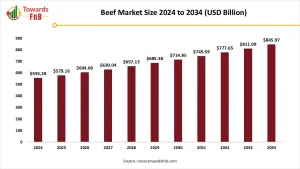The global beef market remains one of the most widely consumed sources of animal protein globally, valued for its taste, nutritional richness, and culinary versatility. Despite growing competition from alternative proteins, the global beef market continues to thrive, driven by rising population, urbanization, and increasing demand for high-protein diets.
This blog explores the multifaceted landscape of the beef market, analyzing key growth drivers, challenges, segmentation trends, and regional dynamics expected to shape the industry between 2025 and 2034.

Market Overview
The global beef market is a vital component of the broader meat industry, encompassing the production, processing, and distribution of beef products sourced from cattle. From fresh and frozen cuts to processed and value-added products, beef plays a central role in the diets of billions worldwide.
While traditional markets like the U.S., Brazil, and Australia remain major producers and exporters, growing consumption in Asia-Pacific and Africa is opening new frontiers. Moreover, advances in cold chain logistics, packaging, and traceability are enhancing the global supply chain for beef.
Get a Sample Now: https://www.towardsfnb.com/download-sample/5477
Market Dynamics
Key Drivers
- Rising Demand for High-Quality Protein: With growing awareness about balanced diets and protein intake, beef is gaining preference among fitness-focused and nutritionally conscious consumers.
- Population Growth and Urbanization: Increasing urban middle-class populations in developing countries are driving demand for convenient, protein-rich meat products.
- Foodservice and QSR Expansion: The growth of global food chains and quick-service restaurants (QSRs) is fueling demand for ground beef, burgers, steaks, and processed items.
- Export Opportunities: Countries with surplus production like Brazil, Australia, and the U.S. are strengthening exports to Asia and the Middle East due to rising demand.
Market Restraints
- Sustainability Concerns: The beef industry faces scrutiny over greenhouse gas emissions, land use, and water consumption, prompting calls for more sustainable practices.
- Health Perceptions: Increased focus on cardiovascular health and plant-based diets may reduce consumption in health-conscious segments.
- Price Volatility: Feed costs, droughts, and geopolitical issues can create instability in beef pricing, impacting both producers and consumers.
Market Growth Factors
- Emerging Middle-Class Consumers in Asia and Africa
Rising incomes in emerging markets are driving meat consumption, with beef viewed as a premium source of protein and social status. Rapid urbanization and improved cold chains are enabling easier access.
- Technological Advancements in Cattle Farming
The integration of AI, genetic improvements, disease tracking, and smart feeding technologies is boosting productivity, quality, and traceability in the beef supply chain.
- Demand for Value-Added and Ready-to-Cook Products
Busy urban lifestyles have led to an increase in demand for marinated, pre-cut, and heat-and-eat beef products, especially among millennials and Gen Z.
- Halal and Kosher Beef Segments
With a growing global Muslim and Jewish population, there is an increasing market for certified halal and kosher beef, particularly in the Middle East, Southeast Asia, and parts of Europe.
Opportunities in the Beef Market
- Premiumization and Branded Beef
There’s growing interest in grass-fed, organic, hormone-free, and Wagyu beef among affluent consumers seeking higher quality and traceability.
- Export Growth in Developing Markets
Strategic trade agreements and investments in meat processing infrastructure present opportunities for exporters to tap into countries like Vietnam, Indonesia, UAE, and Nigeria.
- Sustainability Certifications and Carbon-Labeling
Brands adopting sustainable cattle farming and offering eco-labeled beef are likely to attract climate-conscious consumers and institutional buyers.
- E-commerce and Direct-to-Consumer (DTC) Models
Online platforms offering frozen, fresh, or gourmet beef cuts delivered to homes are gaining traction, especially in urban centers.
Grab the Databook and Discover Key Industry Insights Instantly: https://www.towardsfnb.com/download-databook/5477
Segmentation Analysis
By Product Type
- Fresh/Chilled Beef
- Frozen Beef
- Processed Beef (sausages, patties, meatballs)
- Cured/Preserved Beef (jerky, corned beef)
By Cut Type
- Ground Beef
- Brisket
- Chuck
- Rib
- Sirloin
- Tenderloin
- Others
By End User
- Households
- Hotels, Restaurants, and Catering (HoReCa)
- Food Processing Industry
- Retail & Wholesale
By Distribution Channel
- Supermarkets/Hypermarkets
- Butcher Shops
- Online Retail
- Specialty Meat Stores
- Foodservice Distributors
Regional Insights
North America
- North America, particularly the United States, remains one of the top consumers and producers of beef. The U.S. leads in premium beef, fast-food demand, and high-value cuts, while also being a major exporter to Asia. Canada and Mexico are important contributors with strong domestic markets and trade ties under USMCA.
Latin America
- Countries like Brazil, Argentina, and Uruguay dominate beef exports globally. Brazil, in particular, is a leader in large-scale beef production, with significant trade relationships with China, the EU, and the Middle East.
Europe
- Beef consumption is mature in Western Europe but increasingly conscious of animal welfare and sustainability. Demand for grass-fed and organic beef is rising. Eastern Europe shows potential for growth due to changing diets and income improvements.
Asia-Pacific
- Asia-Pacific is witnessing explosive demand growth, led by China, India (buffalo meat), Japan, South Korea, and Vietnam. Rising urbanization, disposable income, and changing dietary habits are fueling demand for both fresh and imported beef.
Middle East & Africa (MEA)
- The MEA region shows rising demand for halal-certified beef and imported frozen beef. Countries like Saudi Arabia, UAE, and South Africa are investing in cold chain logistics to boost domestic supply and imports.
Outlook and Future Opportunities
The global beef market is entering a transformative phase driven by shifting consumer preferences, trade expansion, technological advancements, and sustainability imperatives. While traditional consumption remains strong in mature markets, the real growth lies in emerging economies where beef is increasingly seen as both a staple and a status symbol.
Brands that embrace ethical sourcing, traceability, value-added products, and consumer convenience will lead in the next decade. Amid growing competition from plant-based and alternative proteins, the beef industry must innovate and adapt to maintain its global dominance.